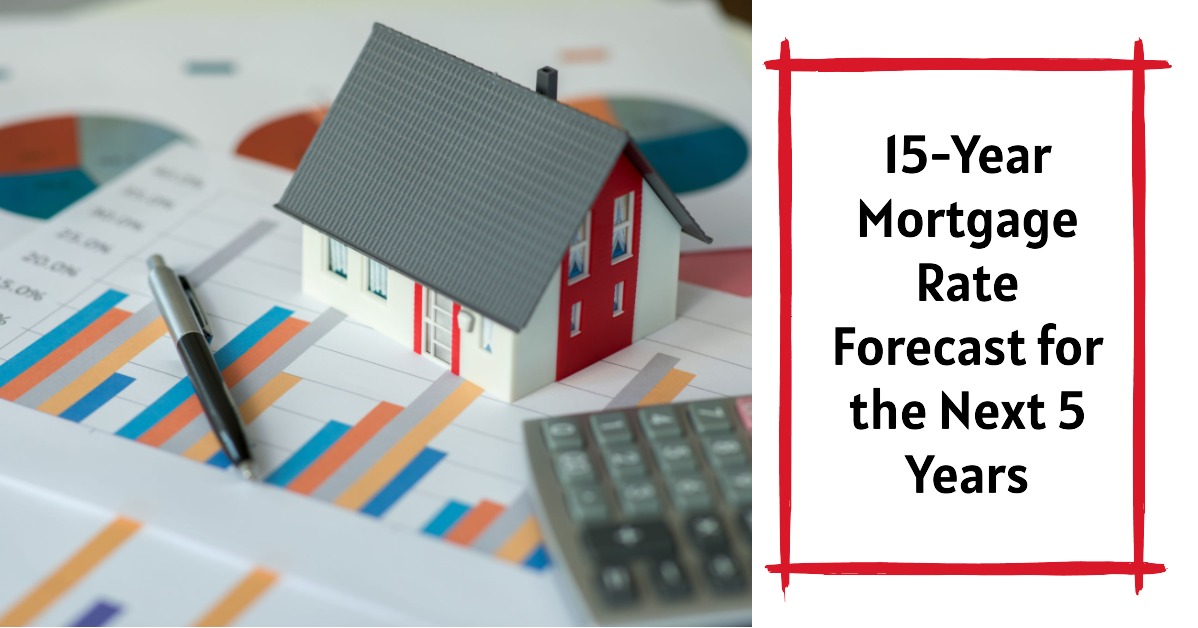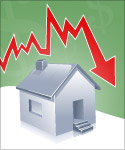If you're like me, the thought of a mortgage can be both exciting and a little daunting. We all want to know what's around the corner, especially when it comes to something as big as buying a home. The good news is, if you're eyeing a 15-year fixed-rate mortgage, current forecasts suggest a gradual decline over the next few years, with rates likely stabilizing by the end of the decade. While there are always factors that can cause fluctuations, this general outlook can help you make informed decisions about your future.
15-Year Mortgage Rate Forecast: What to Expect in the Next 5 Years
Current State of 15-Year Mortgage Rates
Right now, the average 15-year fixed-rate mortgage is sitting around 6.14%. Now, I know that might feel a bit high, especially if you remember the really low rates we saw a few years back. While it's true that it's more expensive than the 2020-2021 lows, we've seen some stability in recent months. This is basically the result of a tug-of-war between the Federal Reserve's policies, ongoing inflation concerns, and the overall vibes in the housing market.
Key Factors Influencing 15-Year Mortgage Rates
It's not just random numbers being thrown around. Several big things impact where mortgage rates end up:
1. Federal Reserve Policy
Think of the Federal Reserve (or “the Fed”) as the central bank of the US, kind of like the conductor of our economic orchestra. Their decisions about interest rates have a direct impact on mortgage rates. Since 2024, the Fed has lowered rates a few times, bringing their federal funds rate to a range of 4.25%-4.50%. However, they're being really careful about inflation and the job market, so further rate cuts are likely to be slow and small. What does this mean for us? It means big drops in mortgage rates are unlikely in the immediate future.
2. Inflation and Economic Growth
Inflation is still hanging around like that one guest who overstays their welcome. It has cooled down since its peak in 2023, but it's still above the Fed's target of 2%. This persistent inflation is one of the main reasons mortgage rates are staying relatively high. On the other hand, a strong job market usually leads to higher rates, while a sluggish economy might push rates down.
3. Housing Market Dynamics
The housing market is a bit of a puzzle right now. The lack of homes for sale compared to the high demand is keeping both house prices and mortgage rates elevated. More and more people, especially millennials, are looking to buy, which is adding to this pressure. If mortgage rates drop in the future, that might encourage more homeowners to sell, which could help ease things up.
Expert Predictions for 15-Year Mortgage Rates
Okay, so what do the people who study this stuff day in and day out think is going to happen?
2025-2026: Gradual Decline
The most common prediction from experts is that we'll see a slow decrease in 15-year mortgage rates over the next couple of years. For instance:
- The Mortgage Bankers Association (MBA) is forecasting an average of 6.4% in 2025, dropping slightly to 6.2% by the end of 2026.
- Fannie Mae is expecting rates to hang around 6.3%-6.4% during this time.
This means while they aren't going to plummet, they're expected to move downward little by little.
2027-2029: Stabilization and Potential Upswing
By 2027, experts think that rates will probably stabilize. Some think we might even see a slight increase due to things like changes in population and more government spending. The National Association of Realtors (NAR) predicts rates will be around 5.8%-6.0% during this period. This would be a more normal level than what we've seen in recent times.
Long-Term Trends and Considerations
It’s not enough to just look at the next few years. There are other long-term factors that we need to take into consideration:
1. Demographic Shifts
How many people are moving and who they are matters quite a bit. As older generations downsize and millennials start families, the housing market will continue to be active. This means that the demand for homes will remain strong, which can stop interest rates from falling too low.
2. Global Economic Factors
The world is interconnected, so things happening in other countries affect us too. Trade disputes, energy issues, and other global events can cause inflation, which in turn, pushes mortgage rates higher.
3. Technological and Regulatory Changes
New technology in banking and possible changes to mortgage rules can also have an effect. For example, more competition among lenders or new government programs aimed at making homes more affordable can help to give better rates to people who want to buy homes.
Practical Advice for Homebuyers and Refinancers
So, what should you do with all this information? Here's my take:
1. Timing Your Purchase or Refinance
While it's tempting to wait for the perfect moment with the lowest rates, I wouldn't get too hung up on it. If you find a house you love, and the rate fits your budget, don't wait too long. Locking in a rate that works for your financial goals is often better than trying to time the market perfectly. There's no crystal ball.
2. Improving Your Financial Profile
Here's a piece of advice that always holds true: The better your credit score and the more stable your income, the better the rate you'll get. It’s worth it to spend time improving these areas. Also, shop around! Get quotes from several lenders; you'd be surprised how much it can save you in the long run.
3. Exploring Alternative Loan Options
If you expect to move or refinance soon, check out adjustable-rate mortgages (ARMs) or rate buydowns. These can give you some flexibility and lower payments at the start of your loan.
Recommended Read:
More Data and Detailed Forecasts
Let’s delve a little deeper. The Economy Forecast Agency (EFA), which specializes in long-range financial market forecasts, provides some interesting predictions. They are independent from banks and other market players, which gives credibility to the data. Here’s what they forecast for 15-year mortgage rates:
15-Year Mortgage Rates for 2025
| Month | Low | High | Close | Mo, % | Total, % |
|---|---|---|---|---|---|
| Jan | 6.13% | 6.55% | 6.36% | 3.8% | 3.8% |
| Feb | 6.06% | 6.44% | 6.25% | -1.7% | 2.0% |
| Mar | 6.04% | 6.42% | 6.23% | -0.3% | 1.6% |
| Apr | 6.17% | 6.55% | 6.36% | 2.1% | 3.8% |
| May | 5.66% | 6.36% | 5.83% | -8.3% | -4.9% |
| Jun | 5.30% | 5.83% | 5.46% | -6.3% | -10.9% |
| Jul | 5.25% | 5.57% | 5.41% | -0.9% | -11.7% |
| Aug | 5.15% | 5.47% | 5.31% | -1.8% | -13.4% |
| Sep | 5.00% | 5.31% | 5.15% | -3.0% | -16.0% |
| Oct | 4.98% | 5.28% | 5.13% | -0.4% | -16.3% |
| Nov | 4.92% | 5.22% | 5.07% | -1.2% | -17.3% |
| Dec | 4.82% | 5.12% | 4.97% | -2.0% | -18.9% |
15-Year Mortgage Rates for 2026
| Month | Low | High | Close | Mo, % | Total, % |
|---|---|---|---|---|---|
| Jan | 4.64% | 4.97% | 4.78% | -3.8% | -22.0% |
| Feb | 4.21% | 4.78% | 4.34% | -9.2% | -29.2% |
| Mar | 4.00% | 4.34% | 4.12% | -5.1% | -32.8% |
| Apr | 4.12% | 4.43% | 4.30% | 4.4% | -29.9% |
| May | 4.16% | 4.42% | 4.29% | -0.2% | -30.0% |
| Jun | 4.29% | 4.60% | 4.47% | 4.2% | -27.1% |
| Jul | 4.25% | 4.51% | 4.38% | -2.0% | -28.5% |
| Aug | 4.12% | 4.38% | 4.25% | -3.0% | -30.7% |
| Sep | 4.13% | 4.39% | 4.26% | 0.2% | -30.5% |
| Oct | 3.97% | 4.26% | 4.09% | -4.0% | -33.3% |
| Nov | 3.82% | 4.09% | 3.94% | -3.7% | -35.7% |
| Dec | 3.66% | 3.94% | 3.77% | -4.3% | -38.5% |
15-Year Mortgage Rates for 2027
| Month | Low | High | Close | Mo, % | Total, % |
|---|---|---|---|---|---|
| Jan | 3.40% | 3.77% | 3.50% | -7.2% | -42.9% |
| Feb | 3.18% | 3.50% | 3.28% | -6.3% | -46.5% |
| Mar | 3.08% | 3.28% | 3.18% | -3.0% | -48.1% |
| Apr | 3.18% | 3.68% | 3.57% | 12.3% | -41.8% |
| May | 3.57% | 4.13% | 4.01% | 12.3% | -34.6% |
| Jun | 4.01% | 4.28% | 4.16% | 3.7% | -32.1% |
| Jul | 3.88% | 4.16% | 4.00% | -3.8% | -34.7% |
| Aug | 4.00% | 4.49% | 4.36% | 9.0% | -28.9% |
| Sep | 4.15% | 4.41% | 4.28% | -1.8% | -30.2% |
| Oct | 4.28% | 5.20% | 5.05% | 18.0% | -17.6% |
| Nov | 5.05% | 5.64% | 5.48% | 8.5% | -10.6% |
| Dec | 5.48% | 6.16% | 5.98% | 9.1% | -2.4% |
15-Year Mortgage Rates for 2028
| Month | Low | High | Close | Mo, % | Total, % |
|---|---|---|---|---|---|
| Jan | 5.98% | 7.17% | 6.96% | 16.4% | 13.5% |
| Feb | 6.42% | 6.96% | 6.62% | -4.9% | 8.0% |
| Mar | 6.62% | 7.07% | 6.86% | 3.6% | 11.9% |
| Apr | 6.86% | 7.58% | 7.36% | 7.3% | 20.1% |
| May | 7.06% | 7.50% | 7.28% | -1.1% | 18.8% |
| Jun | 7.22% | 7.66% | 7.44% | 2.2% | 21.4% |
| Jul | 6.53% | 7.44% | 6.73% | -9.5% | 9.8% |
| Aug | 6.67% | 7.09% | 6.88% | 2.2% | 12.2% |
| Sep | 6.67% | 7.09% | 6.88% | 0.0% | 12.2% |
| Oct | 6.24% | 6.88% | 6.43% | -6.5% | 4.9% |
| Nov | 6.43% | 7.28% | 7.07% | 10.0% | 15.3% |
| Dec | 6.86% | 7.28% | 7.07% | 0.0% | 15.3% |
The data indicates that rates are expected to decrease to as low as 3.18% by March of 2027 but increase later to 7.07% by the end of 2028. These fluctuations highlight that while experts can predict, market conditions can dramatically change over a period of time.
A Quick Look At 2025 Monthly Predictions
- January 2025: Expect rates to move between 6.13% and 6.55%, with an average around 6.29% and a closing rate of 6.36%.
- February 2025: Rates should range from 6.06% to 6.44%, with an average around 6.28% and closing at 6.25%.
- March 2025: Expect rates to move between 6.04% and 6.42%, averaging 6.24% and closing at 6.23%.
- April 2025: Look for rates between 6.17% and 6.55%, averaging about 6.33% and closing at 6.36%.
- May 2025: Anticipate a drop to between 5.66% and 6.36%, averaging 6.05% and closing at 5.83%.
- June 2025: Rates should range from 5.30% to 5.83%, averaging 5.61% and closing at 5.46%.
- July 2025: Expect between 5.25% and 5.57%, averaging 5.42% and closing at 5.41%.
- August 2025: Rates should be between 5.15% and 5.47%, averaging 5.34% and closing at 5.31%.
- September 2025: The range is between 5.00% and 5.31%, averaging 5.19% and closing at 5.15%.
- October 2025: Expect rates between 4.98% and 5.28%, averaging 5.14% and closing at 5.13%.
- November 2025: Rates should move between 4.92% and 5.22%, averaging 5.09% and closing at 5.07%.
- December 2025: Look for rates between 4.82% and 5.12%, averaging 5.00% and closing at 4.97%.
Conclusion
The 15-year mortgage rate forecast for the next five years isn't a straight line. It’s more like a winding road with some ups and downs. The general trend, however, points towards a gradual decline over the next few years, stabilizing in the latter half of the decade. However, the economy is always changing, so rates could go up or down.
Ultimately, staying informed and working with financial professionals you trust is key to navigating this process. If you're a potential homebuyer or want to refinance, be strategic and always be prepared to adjust your plans as needed.
Navigate Rising Mortgage Rates with Norada
With today's mortgage rates on the rise, investing in turnkey real estate can help you secure consistent returns.
Expand your portfolio confidently, even in a shifting interest rate environment.
Speak with our expert investment counselors (No Obligation):
(800) 611-3060
Related Articles:
- Fed Funds Rate Forecast 2025-2026: What to Expect?
- How Low Will Interest Rates Go in the Coming Months?
- Fed Just Made a BIG Move by Slashing Interest Rates to 4.75%-5%
- Market Reactions: How Investors Should Prepare for Interest Rate Cut
- Interest Rate Predictions for the Next 3 Years: (2024-2026)
- Interest Rate Predictions for Next 2 Years: Expert Forecast
- Impact of Interest Rate Cut on Mortgages, Car Loans, and Your Wallet
- Interest Rate Predictions for Next 10 Years: Long-Term Outlook
- When is the Next Fed Meeting on Interest Rates?
- More Predictions Point Towards Higher for Longer Interest Rates



